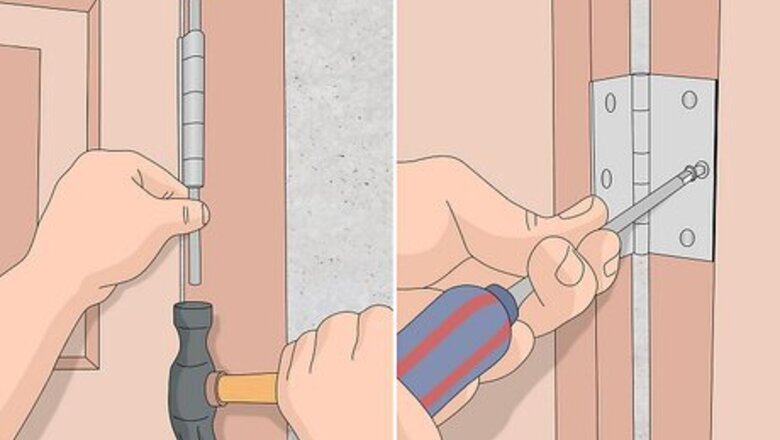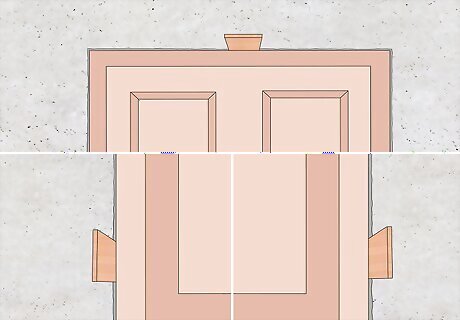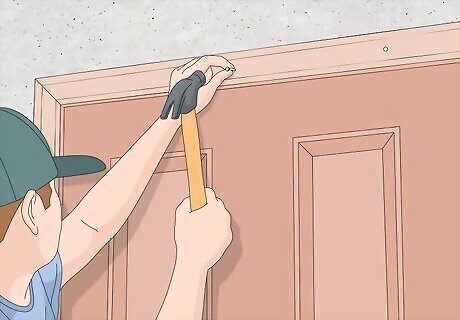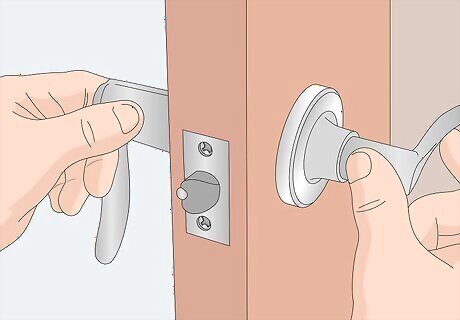
views
Remove the existing door, if necessary.

Pull the hinge pins from the old door, then remove the hinges from the jamb. To remove a door hinge pin, put the flat end of a nail punch against the pin and tap it up with a hammer. Once the pin is raised a few centimeters, take a screwdriver to pry it up. Repeat on all hinges. Unscrew the hinge brackets from the door jamb. Once the door is loose, gently lift it with your hands from the rough opening. Lay it flat against the floor or dispose of it.
Level and shim the door in position.

Slide the prehung door into the rough opening and level it. Take your prehung door and fit it into the rough opening. Get it as flush as possible with the drywall. Then, open the door 90 degrees and shim the door frame so it's level with the head jamb (the top horizontal section). Slide the shims between the frame and drywall on the top, left, and right sides of the door so the door is perfectly level. Shims are tapered, so stack them opposite of one another to ensure the door remains even. Before positioning the prehung door, check the level of your flooring with a level. If your flooring is uneven, identify the highest point on the floor. Use a circular saw to trim the door jamb on the high side. To get the right-sized prehung door, measure the rough opening. Home Improvement Specialist Ryaan Tuttle says, “Measure the top width. Measure the bottom width. Make sure they’re the same. Then, measure your height on the right and left side. Take all the smallest numbers you have, and that will be the door size.”
Nail the door frame to the studs.

Drive two nails through each shim 1 in (2.5 cm) from the edge of the jamb. Before sending finishing nails through the jamb, check that the door is leveled and opens smoothly. If it does, use a brad nailer to nail two 6 in (15 cm) finishing nails into each shim to secure the door in place. If any shims are sticking out, take a utility knife to score it and snap the excess wood off.
Install the door trim.

Nail the trim to the door frame to conceal the door jamb. Professional Handyman Barry Zakar suggests cropping the trim’s corners and edges where they meet the wall. This way, you can properly install the trim all around the opening, except the floor. Nail the trim in place with 6 in (15 cm) finishing nails. Space the nails 16 inches (41 cm) apart. Work one section at a time.
Fill any gaps and nail holes.

Cover any imperfections with caulk or wood filler. If you notice any gaps around the trim, go in with a caulk gun and apply a bead of caulk to fill it in. Use your finger to wipe away any excess residue and let it dry overnight. Similarly, Professional Handyman Barry Zakar says to use spackle over nail holes before sanding it down with sandpaper and repainting, if necessary. You can paint the trim with a paintbrush, but that's optional.
Attach the new lockset.

Screw the doorknob and additional accessories in place. Generally, prehung doors come with attached hinges and pre-cut holes for a doorknob and strike plate. However, you'll need to purchase new or reuse the accessories from your previous door. Use the included hardware to install the door knob. Slide the latch in the latch plate and insert the latch through the hole for the doorknob. Then, install a doorknob on either side of the hole and screw them in place. Finish by installing the strike plate onto the door jamb, opposite the latch.


















Comments
0 comment